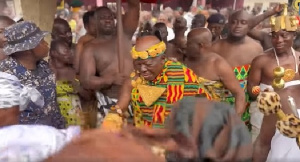In the Ashanti Kingdom or Ashanti Confederacy of centuries ago, the Asantehene exercised vast powers over the member states within the Kingdom or Confederacy, hence they were called the Overlord of Ashanti. Even in those days, he could not claim total ownership to the stools and lands of the various principal states within the union of chiefs or divisions called the Asante Kingdom.
Since 1935, when the abrogated Ashanti Kingdom was reformed, the authority of the Asantehene as the Overlord of the Asante Kingdom was removed. The Kingdom ceased to exist only to be replaced by a grouping of paramountcies, now called Asanteman Council, with the Asantehene become a Ceremonial Head with limited powers.
Therefore, there is no king but chief(s) in Ghana. Again, there is no Kingdom in Ghana since that time. With the advent of Ghana’s independence and the nation becoming a republic, any idea or discussion of Kingdom within Ghana was buried for good.
There is a well-documented record on the cadastral demarcation of Ashanti land among the principal divisions, thus, the paramountcies, within the region or the Asanteman Council. The demarcations were carried out, and certified, by, Sir Francis Charles Bernard Dudley Fuller, CMG, KBE (1866–1944). He was appointed Chief Commissioner to the Ashanti Region in 1908.
Each division was called a paramountcy with their head called paramount chief (Omanhene) to date.
What is a paramountcy, one may ask? It is defined as, “the fact or state of being above others in rank or importance; supreme power or authority”.
In today’s Asanteman Council, we have the Kumasi, Kumawu, Juaben, Mampong, Ofinso, Essumeja, Kokofu, Bekwai, etc., paramountcies or divisions. The heads of these divisions are equally powerful and the stools and land they occupy belong to them. They hold them in trust for the subjects of their division.
Although, the head of the Kumasi division who doubles as the Ceremonial Head of Asanteman, being the Asantehene and regarded as the primus inter pares, has not any absolute power over any of the paramount chiefs to decide to destool or enstool them as and when he likes. The power to do that is the prerogative of the queen, the family head of the royal family of that division and the sub-chiefs in that paramountcy, according to their local custom and traditions which are almost similar across Asanteman.
By the little said above, it can emphatically be concluded that it is for lack of knowledge, if not out of cowardice, or erroneous, on the part of many an Ashanti and their historians, to assert that all stools and land in Ashanti region, or Asanteman, belong solely to the Asantehene. They are not! And anyone buying into that idea does not know the history of Ashanti and their developmental stages as were amended by the British Colonialists during and after the reformation of the Asante Confederacy in 1935.
For anyone, or the Asantehene himself, to claim that all land and stools in Asanteman or Ashanti region belong to the Asantehene, the occupant of the Golden Stool, that person must be hallucinating, or dreaming big time.
Therefore, for some paramount chiefs that are less knowledgeable about the Asante history to fully support the current Asantehene, Otumfuo Osei Tutu II, on his claims to owning full ownership to Ashanti land and stools is very irresponsible on their part.
Do we blame such chiefs? No, because the current Asantehene in his own devises for his selfish and parochial interests has installed otherwise completely ineligible persons as paramount chiefs in some of the paramountcies
He brags about his ability to have imposed a person of his choice on Kumawu paramountcy as their paramount chief, then doing same in Essumeja.
None of the Asanteman chiefs has been able to stand up to him openly or secretly on these perpetrations of abuse of power by the Asantehene, except for Rockson Adofo, the no-nonsense, proud, and fearless son of Kumawu/Asiampa soil, to come out to challenge him online with credible evidence.
I am publishing this article following a warning statement by the family head of the Antoa royal family to then 96-year-old chief, Nana Owusu Agyemang, when the chief had decided to install his nephew as chief.
Following the chief’s insistence to enstool his nephew against all odds, he has now been deposed by Asantehene
Refer to a publication under the General News of Thursday, 28 December 2023 on Ghanaweb, titled, “I was here before the Asantehene’ – Antoahene on why he enstooled a chief without Otumfuo’s approval”.
‘I was here before the Asantehene’ – Antoahene on why he enstooled a chief without Otumfuo’s approval
The family head had warned, “In the Ashanti Kingdom, every stool belongs to Asantehene so he cannot enstool a chief without approval from the King”
This publication is to correct the Antoa royal family head and the like-minded people.
Yes, Antoa may be under the jurisdiction of the Asantehene to do as he likes when he wants, however, he cannot do same in every paramountcy if Ashantis and their chiefs did honestly know and understand the custom and traditions of their various paramountcies and the rules and regulations of the Asanteman Council.
The Asanteman Council, previously called the Asante Kingdom or Asante Confederacy, is a union of loose states held together by trust, respect for each member paramountcy, but not by disrespect, force, and abuse of power as often seen to be exercised by the current Asantehene, the self-proclaimed most powerful individual in Ghana, feared by all, including presidents, politicians, lawyers and judges, except that son of Kumawu/Asiampa.
Rockson Adofo

